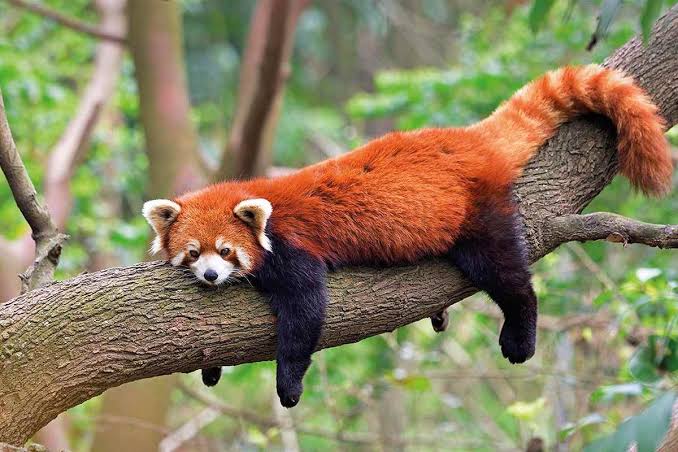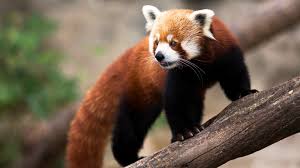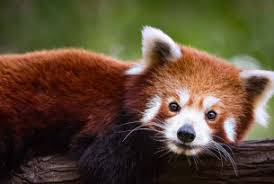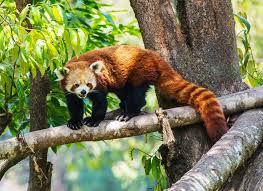Red panda is an adorable animal that lives in the forests of Asia. It looks like a mix between a raccoon and a bear, with reddish-brown fur, a long tail, and a cute face. Red pandas are not very big, about the size of a house cat.
They spend most of their time in trees, climbing and jumping from branch to branch. These animals are really good at climbing because they have sharp claws that help them grip onto the trees. Their tails are super useful too; they use them for balance when they’re up high in the trees.
What do red pandas eat? Well, they mostly munch on bamboo, but they’re not picky eaters. Sometimes they also enjoy fruits, insects, eggs, and even small animals. They’re not big fans of hunting, though. They prefer to peacefully eat their food up in the trees.
One cool thing about red pandas is that they are solitary creatures, which means they prefer to be alone. They make little homes in hollow trees or burrows, and they mark their territory by using scent glands in their bodies.
These cute critters are shy and quiet. They don’t make a lot of noise, except for some small squeaks or whistles to communicate with each other. They have this really gentle way of getting around, and when they’re not munching on bamboo, they often nap in cozy spots high up in the trees.
Red pandas are unique and special creatures that need our help to survive. Unfortunately, their homes are getting smaller because of deforestation, and this puts them in danger. People around the world are working hard to protect these lovely animals and their homes, so we can keep enjoying their cuteness for a long, long time.
Red pandas have these beautiful bushy tails that are really handy. They use their tails like a warm blanket to cover themselves when it’s chilly. It’s like having a built-in scarf to keep them cozy! Another interesting thing about red pandas is their cute faces. They have white patches on their cheeks that make them look like they’re wearing masks. Maybe they’re secret superheroes of the forest!
When red pandas have babies, called cubs, they’re super tiny and helpless. The moms take good care of their babies, keeping them safe and warm until they’re ready to explore the world on their own. These little ones stick around with their moms for about a year before they become independent.
Even though red pandas are mostly chill and relaxed, they can be playful too! They love to roll around and play games, especially when they’re young. Just like human kids, they’re curious and full of energy.
Because they’re so cute and adorable, some people think red pandas would make good pets. But in reality, they’re wild animals and need to stay in their natural homes. They’re happiest and healthiest when they’re roaming freely in the forests.
Conservation efforts are crucial to ensure that red pandas continue to thrive. By protecting their habitats and raising awareness about these amazing animals, we can make sure they have a safe place to live and flourish for generations to come.
Read Also: How to Raise Ruminant Animals for Fattening and Reproduction together
History and Origin of Red Panda

Red pandas have a long history of living in the forests of Asia. They’ve been around for a very, very long time, but scientists didn’t know a lot about them until more recent times.
People in Nepal and China have known about red pandas for centuries. In Nepal, they call them “Nigalya ponya” which means “bamboo footed” because these creatures love to munch on bamboo. In China, they’re called “hunho” or “firefox” because of their fiery red fur and fox-like appearance.
Western scientists first heard about red pandas in the 1800s. They were so unique that at first, they weren’t sure where to put them in the animal kingdom. Some thought they were related to raccoons, while others believed they were more like bears. But after studying them carefully, scientists discovered that red pandas have their very own special family called Ailuridae, and they’re the only living members of this family.
As people learned more about these fascinating animals, they became very popular in zoos around the world. Zoos started breeding red pandas to help protect them because their numbers were decreasing in the wild due to habitat loss and other threats.
Today, scientists and conservationists are working hard to study and protect red pandas. They want to make sure these charming creatures continue to thrive in their natural homes and don’t disappear from our world. By understanding their history and origin, we can better protect and appreciate these wonderful animals.
The Health and Lifespan of Red Panda
Red pandas, like many animals, need to stay healthy to live their best lives. They’re pretty good at taking care of themselves, but they can get sick just like we do.
One thing that’s important for red pandas is their diet. They mostly eat bamboo, but they also enjoy other foods like fruits, insects, and eggs. Eating a balanced diet helps keep them strong and healthy. Sometimes they can get stomach problems if they eat something they’re not used to, so it’s essential for them to stick to their usual foods.
Just like humans, red pandas can catch colds and other illnesses. They might sneeze or cough when they’re not feeling well. But most of the time, they’re pretty tough and can recover quickly if they get sick.
When they’re living in their natural homes, red pandas can live for about 8 to 12 years. But in zoos, where they get lots of care and attention, they might live a bit longer, sometimes up to 15 years or more.
Taking care of these adorable creatures is important to ensure they stay healthy and live a good, long life. Zookeepers and conservationists work hard to make sure they have everything they need to stay happy and healthy. By understanding their health needs, we can help red pandas thrive for as long as possible.
Read Also: Popular Breeds of Ruminant Animals
Nutrition and Feeding Mode of Red Panda

Red pandas are mostly herbivores, which means they eat plants. Their favorite food is bamboo, and they munch on bamboo leaves, shoots, and stems. They have a special thumb-like extension on their wrist that helps them grip the bamboo while they eat.
Apart from bamboo, red pandas enjoy a variety of foods such as fruits, berries, nuts, eggs, insects, and even small animals occasionally. Their diet can vary depending on what’s available in their habitat. However, bamboo makes up the majority of their diet, and they have a unique digestive system that helps them break down tough bamboo fibers.
When they eat, red pandas usually sit upright and use their front paws to hold their food. They might peel the outer layers of bamboo to get to the softer, tastier parts. They’re not fast eaters; they take their time nibbling and chewing their food, enjoying each bite.
Because bamboo doesn’t have a lot of nutrients, red pandas need to eat a lot of it to get enough energy. They spend a good portion of their day eating, sometimes up to 13 hours, to meet their nutritional needs.
Their diet is crucial to their survival, and conservation efforts focus on protecting their natural habitat and the bamboo forests they rely on for food. By ensuring there’s enough food for red pandas, we can help them stay healthy and happy in their forest homes.
Importance of Red Pandas

Red pandas play an important role in their ecosystem. Even though they’re small, they have a big impact.
Firstly, they help spread seeds from the fruits they eat. When they move around and digest their food, the seeds pass through their bodies and get deposited in different areas. This helps new plants grow in different places, contributing to the diversity of plant life in the forest.
Secondly, red pandas are a part of the food chain. They might be predators to insects or small animals, but they can also be prey to larger animals like snow leopards and wild dogs. This balance helps keep the ecosystem healthy.
Moreover, these furry creatures attract attention and bring people together. By being so cute and charming, they help raise awareness about conservation. People are more willing to protect the forests and habitats where red pandas live because they want to ensure these adorable animals have a safe place to call home.
Their existence is a part of the beautiful web of life in the forests of Asia. Protecting red pandas means safeguarding the balance of nature and ensuring the health of the entire ecosystem they’re a part of.
Red pandas hold significant importance for various reasons:
1. Biodiversity: They contribute to the biodiversity of their habitats. As they move around and eat, they aid in seed dispersal, helping new plants grow and promoting a healthy and diverse forest ecosystem.
2. Indicator Species: Their presence indicates a healthy forest ecosystem. Red pandas need specific forest conditions to thrive, so their well-being reflects the overall health of their habitat. If red pandas are struggling, it could signal issues within the ecosystem that need attention.
3. Conservation Focus: These cute animals raise awareness about conservation. People worldwide are drawn to their adorable appearance, making them ambassadors for conservation efforts. Protecting red pandas means safeguarding their habitats, which benefits many other species sharing the same environment.
4. Economic Value: In some areas, ecotourism related to red pandas brings in revenue. People are interested in visiting regions where they can see these unique creatures in their natural habitat, contributing to local economies and incentivizing conservation efforts.
5. Cultural Significance: Red pandas hold cultural importance in regions where they’re found. They are featured in local folklore, art, and traditions, holding a special place in the hearts of the communities living alongside them.
Overall, red pandas are not only charming and delightful animals but also crucial for the health and balance of their ecosystems and are key indicators of the broader health of our natural world.
Read Also: Complete Steps in Glass Recycling Guide

